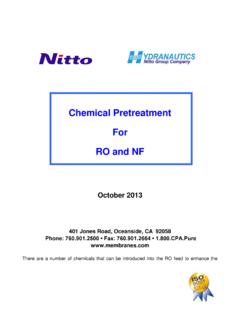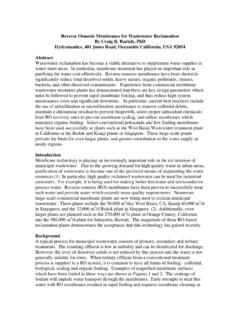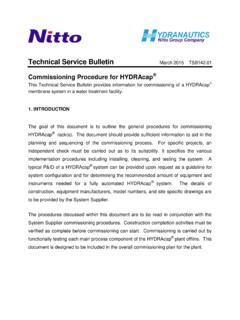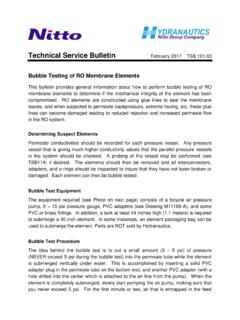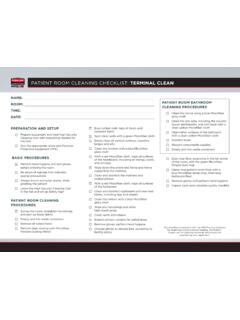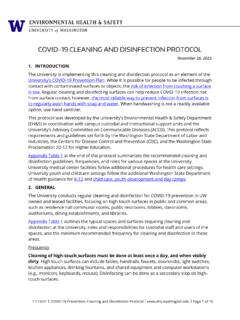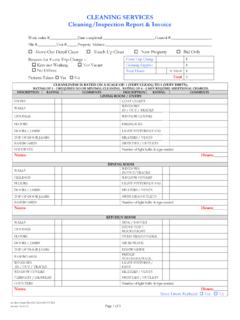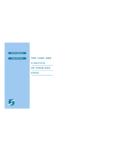Transcription of Cleaning Your RO - membranes.com
1 Wayne T. Bates Cleaning your RO. Eventually the day comes when your RO system will require Cleaning . Cleaning is recommended when your RO shows evidence of fouling, just prior to a long term shutdown, or as a matter of scheduled routine maintenance. Fouling characteristics that signal you need to clean are a 10-15% decrease in normalized permeate flow, a 10-15% decrease in normalized permeate quality, or a 10-15% increase in normalized pressure drop as measured between the feed and concentrate headers. RO Cleaning frequency due to fouling will vary by site. A rough rule of thumb as to an acceptable Cleaning frequency is once every 3 to 12 months.
2 If you have to clean more than once a month, you should be able to justify further capital expenditures for improved RO pretreatment or a re-design of the RO operation. If Cleaning frequency is every one to three months, you may want to focus on improving the operation of your existing equipment but further capital expenditure may be harder to justify. One RO design feature that is commonly over-looked in reducing RO Cleaning frequency is the use of RO permeate water for flushing foulants from the system. Soaking the RO elements during standby with permeate can help dissolve scale and loosen precipitates, reducing the frequency of chemical Cleaning .
3 What you clean for can vary site by site depending on the foulant. Complicating the situation frequently is that one more than one fulant can be present. Typical foulants are: Calcium carbonate scale Sulfate scale of calcium, barium or strontium Metal oxides of iron, manganese, aluminum, etc. Silica scale Colloidal deposits (inorganic or mixed inorganic/organic). Organic material of natural origin or man-made origin Biological (bioslime, mold, or fungi). There are a number of factors involved in the selection of a suitable Cleaning chemical (or chemicals) and proper Cleaning protocol.
4 The first time you have to perform a Cleaning , it is recommended to contact the manufacturer of the equipment, the RO. element manufacturer, or a RO specialty chemical supplier. Once the suspected foulant(s) are identified, one or more Cleaning chemicals will be recommended. These chemical(s) can be generic and available from a number of suppliers or can be private-labeled proprietary Cleaning solutions. The proprietary solutions can be more expensive but may be easier to use and you cannot rule out the advantage of the intellectual knowledge supplied by these companies.
5 An invaluable service offered by some service companies is that they will determine the proper Cleaning chemicals and protocol by testing at their facility an element pulled from your system. It is not unusual to have to use a number of different Cleaning chemicals in a specific sequence to achieve the optimum Cleaning . There are times that a low pH Cleaning is used first to remove foulants like mineral scale, followed by a high pH Cleaning to remove organic material. However, there are times that a high pH Cleaning is used first to remove foulants like oil followed by a low pH Cleaning .
6 Some Cleaning solutions have detergents added to aid in the removal of heavy biological and organic debris, while others have a chelating agent like EDTA added to aid in the removal of colloidal material, organic and biological material, and sulfate scale. An important thing to remember is that the improper selection of a Cleaning chemical or the sequence of chemical introduction can make the foulant worse. There are a number of precautions in Cleaning chemical selection and usage for a composite polyamide membrane: Follow the manufacturer s recommended chemical list, dosage, pH, temperature and contact time guidelines.
7 Use the leash harshest chemical Cleaning to get the job done. This will optimize the useful life of the membrane. Be prudent in the adjustment of pH at the low and high pH range to extend the useful life of the membrane. A gentle pH range is 4 to 10, while the harshest is 2. to 12. Don t mix acids with caustics. Thoroughly rinse the 1st Cleaning solution from the system before introducing the next solution. Flush out detergents with high pH permeate Verify that proper disposal requirements for the Cleaning solution are followed. If your system has been fouled biologically, you may want to consider the extra step of introducing a sanitizing biocide chemical after a successful Cleaning .
8 Biocides can be introduced immediately after Cleaning , periodically ( once a week), or continuously during service. You must be sure however that the biocide is compatible with the membrane, does not create any health risks, is effective in controlling biological activity, and is not cost prohibitive. The successful Cleaning of an RO on-site requires a well designed RO Cleaning skid. Normally this skid is not hard piped to the RO skid and uses temporary hosing for connections. It is recommended to clean a multi-stage RO one stage at a time to optimize crossflow Cleaning velocity.
9 The source water for chemical solution make up and rinsing should be RO permeate, DI water or at least soft water. Components must be corrosion proof. Major Cleaning system components are: RO Cleaning Tank: This tank needs to be sized properly to accommodate the displacement of water in the hose, piping, and pressure vessels. The tank should be designed to allow 100 % drainage, easy access for chemical introduction and mixing, a recirculation line from the RO Cleaning Pump, proper venting, overflow, and a return line located near the bottom to minimize foam formation when using a surfactant.
10 RO Cleaning Pump: This pump needs to be sized to develop the proper crossflow velocity to scrub the membrane clean. The Cleaning rate for a 8-inch diameter vessel is 30 to 40 gpm and for a 4-inch diameter vessel is 8 to 10 gpm. The maximum recommended pressure is 60 psi to minimize the production of permeate during Cleaning and reduce the convective redeposition of foulant back on to the membrane surface. RO Cleaning Cartridge Filter: Normally 5 to 10-micron and is designed to remove foulants that have been displaced from the Cleaning process. RO Tank Heater or Cooler: The optimal temperature for Cleaning is 35 to 45 C.

